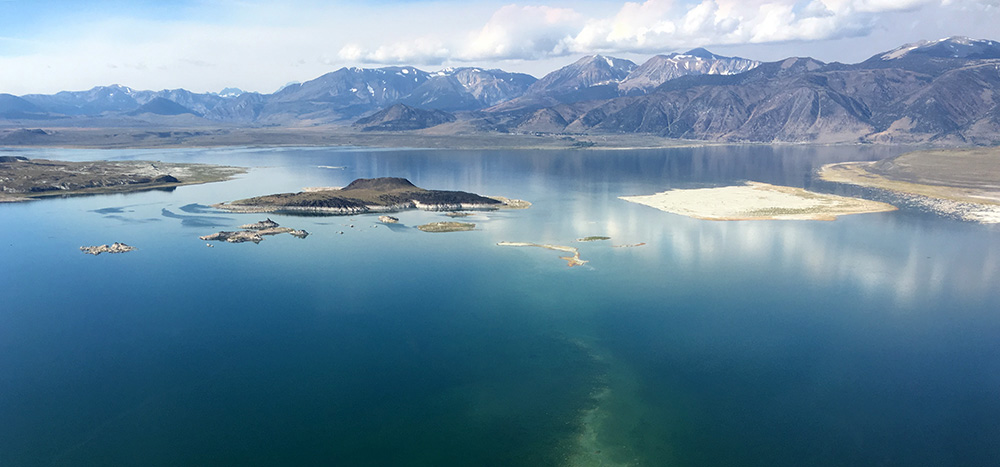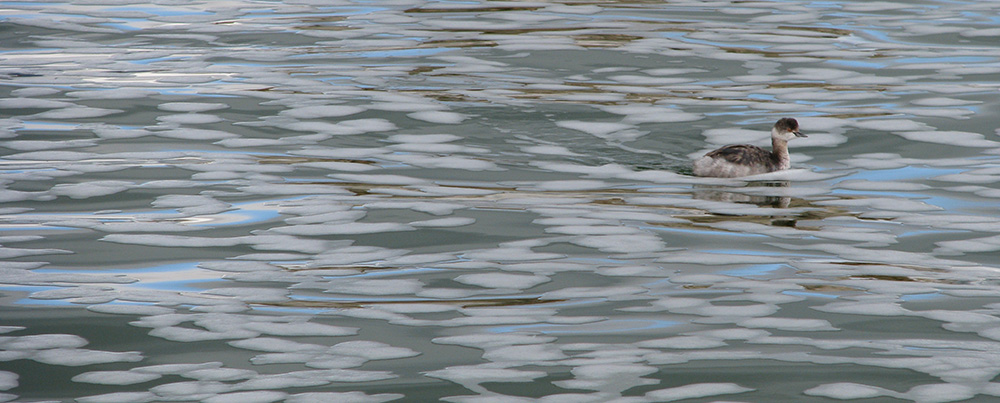
More than 90% of all Eared Grebes in North America stop at either Mono Lake or Great Salt Lake to feed on brine shrimp before continuing their migration to wintering grounds in the southern United States and Mexico. Each year more than a million Eared Grebes depend on Mono Lake’s abundant supply of brine shrimp in order to successfully complete their southbound migration.

Efforts to quantify the number of Eared Grebes at Mono Lake started in the 1980s, but it wasn’t until 1996 that a reliable methodology was developed. By flying over the lake in mid-October (when grebes were assumed to be at peak abundance) and using aerial photography, researchers were able to more accurately estimate numbers. Dr. Sean Boyd, a Research Scientist with Environment & Climate Change Canada, has coordinated grebe surveys at Mono Lake since 1996, which have provided invaluable data for understanding the Eared Grebe fall migration through Mono Lake as well as the overall health of the species in North America. Recognizing the value of this research, and our ability to help by being the local, on-the-ground coordinator of flights and volunteer photographers, the Mono Lake Committee began assisting Dr. Boyd with the Eared Grebe surveys in 2008.
Changing abundance patterns?
In the years leading up to 2008, photo surveys indicated a range of 770,000 to 1,800,000 Eared Grebes on Mono Lake in mid-October. The 2008 survey estimated closer to 260,000 grebes—the lowest number since the study began. This raised an important question: Had peak abundance actually decreased, or had it possibly shifted earlier or later?
To answer this question, the Committee worked with Dr. Boyd to increase the number of surveys from one flight in mid-October to five flights conducted bi-weekly from mid-September to mid-November, in order to have a greater chance at counting the peak abundance.
In 2013, the first year of multiple surveys, data showed the peak number of grebes occurred in mid-October. However, in 2014 and 2015 the data showed that the peak happened as early as mid-September, if not earlier. The 2016 photo counts showed peak abundance occurred in mid-October again, but overall abundance was relatively low. These four years of multiple surveys suggest that the fall staging pattern and peak number of grebes on Mono Lake can change dramatically from one year to the next, and suggest that the pre-2013 counts done in mid-October, while accurate, may not have captured peak abundance.

Migration tracking
The variability of grebe numbers at Mono Lake raises other interesting questions: Do Eared Grebes change their migration routes, with some staging at Great Salt Lake in some years and at Mono Lake in others?
This year Dr. Boyd secured Canadian government funding to start answering these questions by equipping 30 Eared Grebes in British Columbia with small geolocators and radio transmitters. The geolocators will give us specific information on when the grebes arrive and depart Mono Lake and Great Salt Lake. After the grebes return to their breeding grounds in British Columbia, Dr. Boyd will retrieve the geolocators and analyze the data to determine information on the timing of their migration, wintering area(s), and migration routes.
While the grebes are at Mono Lake, Committee staff are tracking their radio transmitter signals, which will allow Dr. Boyd’s team to determine the percentage of time the birds spend under water, which will be used to increase the accuracy of the aerial photo counts.
Mono Lake is important habitat for over a hundred bird species, but the reliance of a significant proportion of the entire North American population of Eared Grebes on the lake is particularly impressive. By adding multiple survey flights and telemetry tracking, Dr. Boyd, with the support of the Mono Lake Committee, is seeking to develop better and more accurate information about these amazing birds and the important role Mono Lake plays for them.
Special thanks to LightHawk volunteer pilot Geoff Pope from Black Mountain Air Service for his many years of flying for the annual Mono Lake Eared Grebe surveys.
This post was also published as an article in the Fall 2017 Mono Lake Newsletter (page 9).
